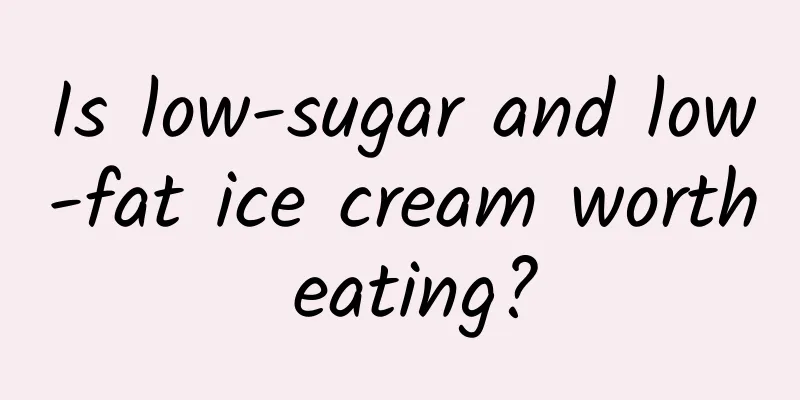Is low-sugar and low-fat ice cream worth eating?

|
Someone asked, a certain ice cream brand recently launched low-sugar and low-fat ice cream, is this product worth buying? Is it a waste of money to eat low-sugar and low-fat ice cream? I answer: These two questions cannot be explained in one sentence. If you have a little patience, please allow me to answer them step by step. After I finish, you will naturally understand. Level 1: Why do you eat ice cream? Because it tastes good. Isn’t drinking plain water or tea lower in sugar and fat? But they are not as delicious as ice cream. Therefore, when making ice cream, the first thing to do is to ensure that it tastes good, rather than requiring it to be low in sugar and fat. Moreover, the premise of developing low-sugar and low-fat products must also be that they taste good. Even if they are not 100% delicious, they must be 70% to 80% delicious. Second layer: How to make delicious ice cream? Because they are filled with lots of delicious ingredients, some of which contain a lot of fat and sugar. What if I leave out all the ingredients that contain fat and sugar? It tasted like ice. What if I reduce the amount of these high-calorie ingredients? I'm afraid its taste will be compromised. If you want to make delicious ice cream, you really need a lot of technical skills. Knowledge Point 1 What are the additives in ice cream for? Take a look at any ice cream from the supermarket freezer and you will find that there are many kinds of food additives. For example: Colorants are used to make the colors look good. They may be natural pigments or artificial pigments, but not all colored ice creams use pigments. For example, a certain brand of sea salt and coconut ice cream is blue because it uses natural phycocyanin. Thickeners are usually some vegetable gums or modified starches. They can make the taste more "meaty" and not feel so "watery" when it melts in the mouth. However, it is important to distinguish that starch has a similar effect but is not an additive. Emulsifiers can blend ingredients such as fat, sugar and water together to make the taste delicate and smooth. Acidity regulators can make the taste sour, and adding sugar will make it sweet and sour. Flavoring can make the characteristic aroma of a certain flavor of ice cream more obvious and pleasant. It's not because the company wants to fool you, but because if you don't add anything, the taste will be affected. In contrast, if you want to use less additives, you have to add more real ingredients. Third layer: How much sugar, fat and protein is in ice cream? This depends on the nutritional information label. I looked at the products sold in supermarkets and found that the fat content of ice cream products is relatively high, while that of popsicles is relatively low. After all, people expect ice cream products to have a rich taste similar to ice cream, and too little fat will not make it rich. For example, fruit popsicles can be fat-free, but they taste watery and cannot be compared to ice cream. ▲ The ingredients and nutritional composition of a popsicle Fat: 0, Carbohydrate: 18.4% The fat content of rich cream ice cream or chocolate ice cream often reaches 20%~30%. ▲ The ingredients and nutritional composition of a chocolate ice cream: Fat content 29.6, carbohydrate content 22.7 Some ice creams with lower fat content, such as those with mung beans, red beans, and glutinous rice as main ingredients, have higher carbohydrate content because sugar and starch play the leading role. ▲ The ingredients and nutritional composition of a mung bean ice cream: Fat content 3.2, carbohydrate content 32.5 I looked at ice cream products in a nearby supermarket and found that the protein content ranged from 1.1% to 7.0%. When eating ice cream, people may not think of supplementing protein. But wouldn’t it be better if you can consume some protein while enjoying the delicious taste? For example, the protein content of "Melissa Milk Ice Cream" is 7.0%, and the protein content of "Sea Salt Coconut Ice Cream" is 6.3%. This level is still very good and has exceeded pure milk and plain yogurt (they need to contain at least 2.9% protein). ▲ Actual photos of the ingredients and nutritional composition of Meili milk ice cream Of course, compared with yogurt and milk, the fat and sugar content of milk ice cream is much higher, but compared with mousse cakes with higher fat content, cookies, and fried dough sticks and potato chips, it cannot be considered a food with low nutritional value. Because, in addition to sugar and fat, we also need to consider the presence of other micronutrients, such as calcium, potassium, B vitamins, and vitamins AD, etc. Although adding cheese and milk powder increases fat, it also increases these beneficial ingredients. Knowledge Point 2 Choose foods based on nutrient density. What I want to recommend to you here is the concept of "nutrient density". It is defined as the ratio of the micronutrient content in a certain food to its calorie content. For example, if you want to supplement calcium, then choosing foods with high calcium content and relatively low calories is the best choice. With the same calcium content, yogurt and milk have a higher nutrient density than ice cream. But on the other hand, for the same calories, choosing milk ice cream is healthier than choosing mousse cake, cookies and sweet drinks because they have less protein and lower calcium nutrient density. So, from a nutritional point of view, milk ice cream is not the best choice, but it is not the worst choice either. Level 4: Are zero sugar, low sugar and reduced sugar the same thing? Knowledge Point 3 Scientific understanding of sweeteners. Sweeteners, the main types include sugar alcohols, such as xylitol, maltitol, erythritol, etc.; high-intensity sweeteners, which are commonly known as artificial sweeteners, such as sodium cyclamate, saccharin (sodium), aspartame, acesulfame potassium, sucralose; and natural sweeteners, such as steviol glycosides, mogrosides, etc. The structures of sugar alcohols are similar to those of sugars and can achieve most of the technological properties of sugars. Sugar alcohol sweeteners are derivatives of sugar. Currently, different products have been developed, including sorbitol, mannitol, erythritol, maltitol, lactitol, xylitol, etc., and their sweetness is about 25% to 100% of sucrose. Sugar alcohol sweeteners provide less energy than sugar, do not cause obvious blood sugar response, and can significantly reduce the risk of tooth decay. At the same time, more and more studies suggest that artificial sweeteners such as saccharin, aspartame, and sucralose not only have taste defects, but long-term consumption may also have adverse effects on appetite control, glucose tolerance, and obesity prevention. Knowledge Point 4 What are the standards for sugar-free, low-sugar and reduced sugar? According to my country's food nutrition labeling regulations, if you want to claim that your food is sugar-free, low-sugar or reduced-sugar, the conditions for meeting the standards are as follows: Sugar-free: < 0.5g sugar/100g solid or 100ml liquid. Low sugar: < 5g sugar/100g solid or 100ml liquid. Reduced sugar: The sugar content is at least 25% lower than similar products. Using sweeteners in moderation to help achieve low sugar or reduced sugar is a feasible approach, but it is not necessary to excessively use sweeteners to pursue the so-called "sugar-free". This not only reduces the risk of consuming too much added sugar, but also avoids the possible adverse effects of consuming a large amount of artificial sweeteners, and the taste is more natural. Fifth level: Controlling sugar, what amount is reasonable? The World Health Organization requires that added sugar be controlled within 50 grams, preferably within 25 grams. There is no evidence that eating a few to 10 grams of added sugar a day will cause health harm. For example, a traditional ice cream weighs about 80 grams, and its carbohydrate content is about 20 grams per 100 grams, so the total amount of sugar it provides is about 16 grams. If you eat one ice cream like this every day and no other sweets or drinks, your intake of added sugar is still within a reasonable range and does not exceed 25 grams. If you are eating a low-sugar version with a sugar content of less than 5 grams per 100 grams, then the sugar content in a stick of ice cream will be even lower, less than 4 grams, so you don't have to worry. In comparison, if you drink a bowl (200 grams) of sweetened soy milk, or a bowl of Tremella soup, to achieve a pleasant sweetness, you need to add 10% sugar, or 20 grams of sugar. Therefore, you don’t have to feel guilty for eating an ice cream that is not “zero sugar”. The key is to control the total amount of all desserts you eat in a day. Level 6: Does low sugar or low fat mean low calories? The calories in a food depend on the amount of fat, protein and carbohydrates in it, as well as the total amount of food. After all, ice cream cannot be made of plain water. If both sugar and fat are extremely low, it will have no gourmet value. Therefore, low-sugar products may not have low fat content, and low-fat products may also have a lot of sugar. To find out exactly how many calories there are, be sure to carefully read the nutrition facts table on the product label. For example, a certain clear ice cream product contains 2.7 grams of protein, 3.0 grams of fat, 17.4 grams of carbohydrates, and a total calorie content of 453 kilojoules (108 kcal) per 100 grams of product. ▲Guava Coconut Ice Cream Ingredients and Nutrition Facts However, this does not mean that the calories of this ice cream are 453 kilojoules. Because this ice cream is only 78 grams, not 100 grams. Its actual caloric value should be 453*0.78 = 353 kilojoules = 84 kcal Knowledge Point 5 What does "one serving" mean on the Nutrition Facts panel? Most products are labeled with "100 grams" as the standard. However, some products' nutrition labels are labeled with "one serving", and one serving may be 50 grams, 60 grams, 80 grams, etc. This labeling is more convenient for consumers, but when compared with other products, if you don't look carefully, you may think that its calorie value is particularly low. Therefore, the data must be converted into 100 grams of content to make a fair comparison. For a 62-gram serving of ice cream, the carbohydrate content in one serving is 15.7 grams, but when converted to 100 grams, it is actually 25.3 grams. ▲Ingredients and nutritional information of a 62g ice cream serving) What should you do if you want to reduce the calorie value of ice cream? It is technically easy to replace sugar with sugar alcohols and other ingredients. However, it is very difficult to replace the satisfaction and aroma produced by fat. It is a good idea to use fruits with rich pulp fiber to provide a dense texture similar to fat, such as the guava coconut ice cream mentioned above, combined with the rich flavor of the fruit. Which one to choose depends on the specific needs of consumers, whether they care about sugar or fat; whether they care about calories or taste, or both. Level 7: Are sugar- and fat-reducing products a waste of money? Knowledge Point 6 The nutritional environment theory holds that whether a person can eat a nutritionally balanced diet is closely related to the food environment in which he lives. If people cannot buy nutritionally adequate food in supermarkets and community food stores, or if there are no nutrition labels on the food so people have no choice, then it will be difficult to achieve healthy eating even if they have this awareness. In order to improve the nutritional environment, the first responsibility of enterprises is to produce a variety of products for consumers to choose from, including products with relatively good nutritional value. In particular, they should take into account the highly educated and highly aware consumer groups who are more concerned about health, and actively develop products with reduced sugar, fat and calories without seriously affecting the taste quality. The second responsibility of enterprises is to inform consumers of the raw materials and nutritional content of products through food labels. Product labels must comply with nutrition labeling regulations, with authentic data and no misleading propaganda. After the company honestly provides relevant information, it is up to the consumer to decide which product to choose. Ice cream is a product that is meant to be consumed for pleasure. The purpose of eating it is not to increase daily nutrient intake or to lose weight. But if it can provide some nutrients, or reduce sugar and fat, and can reduce the mental stress caused by eating, it is naturally not a bad thing and should not be criticized for this. Therefore, ice cream products with reduced sugar and fat cannot be called a waste of money. Some consumers said that it would taste better if the fat and sugar content were not reduced... This is true. With more cream, cheese and chocolate, the flavor will be stronger and the taste will be more enjoyable, which is what we can expect. However, under the premise of using sugar alcohol to replace white sugar or fructose syrup, slightly reducing the sugar content should not have a significant impact on the taste. Since you only eat it for its taste, and you don't have any special needs for controlling sugar or fat, and you don't eat other sweets on a daily basis, then you can definitely choose the traditional regular version. Since you are pursuing deliciousness, just make it delicious to the end. In short, whether to buy ice cream with reduced sugar and fat is a decision entirely on the part of the consumers. Of course, if you don't eat ice cream in the summer, and only drink boiled water, light tea, milk, yogurt, and eat fresh fruits on a daily basis, it is also very healthy... Reprint/ Cooperation please contact Fan Zhihong_Original Nutrition Information |
>>: Planting 939 poppy plants as MSG? This is too "torture"!
Recommend
Async/Await in Swift — Detailed Code Examples
Introduction async-await is part of the structure...
Fourth-generation nuclear energy system, thorium-based molten salt experimental reactor, why can China lead the world?
Energy is an unavoidable topic in development, an...
Is 9H really scratch-proof? Should I put a protective film on my phone?
According to the material of the film, it can be ...
Strategy Analytics: Global 5G smartphone sales are expected to reach 160 million in 2020
Strategy Analytics' latest research report, &...
Apple Pay Development Guide and Human Interface Guide
I translated two articles at work and learned mor...
Poppy looks like a vegetable and you can't really tell them apart? Be careful not to break the law!
recently Public Security Bureau of Dangyang City,...
Skipping breakfast can easily lead to 3 diseases! The first one torments many people...
Today's young people are really too difficult...
Marketing Promotion: Where did the idea for NetEase’s hit H5 come from?
Being creative does not mean going viral, but con...
What have I learned after two years of working on event products?
In the past two years, I have made some products ...
A guide to creating automotive-related short video content!
Hou Wenliang, 43, never dreamed that his interest...
Electric Technology Car News: Can the new Haval H8, which claims to surpass joint venture cars and impact the high-end market, change the fate of domestic SUVs?
Today, the automobile market is still dominated b...
If the earth stopped rotating, where could we survive?
Produced by | Science Popularization China Author...
Android will start charging from February next year
Google is finally ready to take action. Starting ...
24-hour emergency response: Beijing's flu cases increased by 16.69% year-on-year
Hot News TOP NEWS Beijing CDC: Influenza cases in...
2022 Brand Marketing Disruptor
If the first half of 2021 belongs to new consumpt...









